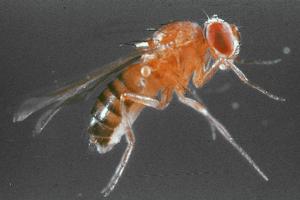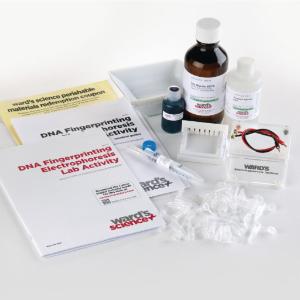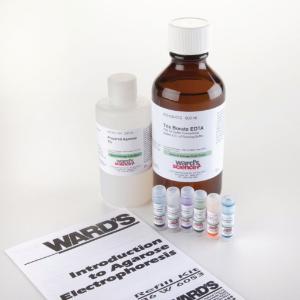Biotechnology facts; Plus a free student handout from AccessScience
Inspire students to explore how biotechnology demonstrates key concepts from biology, chemistry, and physics and its relationship to modern applications within the biological sciences.
Access to this article is being offered to Ward's World readers for free from McGraw Hill's AccessScience. An award-winning gateway to scientific knowledge, AccessScience offers exclusive articles written by prominent scientists, links to primary research material, videos and animations, plus faculty-designed curriculum maps for teachers. To see more content like this, learn about subscription options, and request a free trial for your school, click here.
The team at Ward's World is excited to make available this powerful series of science articles from McGraw Hill’s AccessScience. This unique series fits our mission to find ways to bring you tips, ideas, and resources to help inspire students and guide discovery and learning. Look for a new McGraw Hill’s AccessScience article to be posted each month on Ward's World.
Around 3000 BC, some clever (and brave) Egyptians fermented foods such as cheese and sour milk (yogurt) when they realized it was safer to eat and resisted spoilage better than their raw counterparts.1 They probably didn’t realize it, but they were using basic biotechnology practices. Using bacteria to digest lactose and yeast to ferment sugars to make wine, cheese, and bread are some of the earliest applications of biotechnology. We still use those early applications today, but modern biotechnology is mostly associated with molecular biology, cloning, and genetic engineering.
So, forget about the wheel; it’s the culinary innovations of wine, cheese, and bread that are the crowning jewels of humankind’s achievements! Yea, we stand firmly behind that assessment.
Your biotechnology lesson plans help students see how key concepts from biology, chemistry, and physics apply to modern applications within the biological sciences.
What is biotechnology?
Generally, biotechnology uses technology to use, modify, or upgrade the part or whole of the biological system to benefit industries and human life. There are many examples of how researchers use biotechnology, including in the study of DNA to identify the causes of genetic disorders and methods to cure them. 4 We wouldn’t have crucial vaccines and antibiotics without medical biotechnology.
Some specialized definitions of biotechnology include:
-
- An industrial process that uses scientific research on DNA for practical benefits (recombinant DNA technology)3
- The integrated use of biochemistry, microbiology, and engineering sciences to achieve the technological (industrial) application of the capabilities of microorganisms, cultured tissue cells. (European Federation of Biotechnology)2
- The controlled use of biological agents, such as microorganisms or cellular components (US National Science Foundation)2
The field uses a range of STEM subjects, including biology, mathematics, physics, chemistry, and engineering. The applications for biotechnology range from agriculture to industry, medicine, nutrition, environmental conservation, and cell biology.
Your lessons may inspire some students to add one of these in-demand biotech jobs to their career list:
-
- Med., Clinical Lab Technologists and Technicians
- Medical Scientists
- Biomedical Engineers
- Biological Technicians
- Biochemists and Biophysicists
- Chemical Technicians
- Zoologists and Wildlife Biologists
- Microbiologists
- Genetic Counselors
- Epidemiologists
Download McGraw Hill's AccessScience article on biotechnology above to share with your students; it has comprehensive facts to support or expand your lesson plans. The free download also includes assessment questions and answers you can use to test student understanding. It’s a valuable resource covering an exciting topic.
Download McGraw Hill's AccessScience Teacher Answer key for this article here.
References: 1. https://faculty.weber.edu/coberg/class/3853/3853%20HistoryofFood.htm 2. Essay on Biotechnology: Definition, Advancement, and .... https://www.biologydiscussion.com/essay/biotechnology-essay/essay-on-biotechnology-definition-advancement-and-application/17605%20 3. Cliffnotes.com Microbiology: Recombinant DNA and Biotechnology
4. Biotechnology - Types And Applications Of Biotechnology. https://byjus.com/biology/what-is-biotechnology/
Recommended products
[StartProductBlock]
Science Take-Out® Pathogens, Antibodies, And Vaccines
Students create models of pathogens, antibodies, and antigen-antibody interaction and perform simulated laboratory tests to compare the antibody levels of unvaccinated and vaccinated children who have been exposed to the bacteria that cause pertussis.
[EndProductBlock]
[StartProductBlock]

Drosophila Sets, Live Fruit Flies
Drosophila melanogaster, the common fruit fly, is widely used in genetic studies. Students can study sex-linked, recessive, and dominant mutations. Drosophila also makes an excellent live food for mantises, small reptiles, and amphibians.
[EndProductBlock]
[StartProductBlock]

Ward's® DNA Fingerprinting Electrophoresis Lab Activity
Explore basic elements of forensic science. Students get DNA samples from a “crime scene” to electrophorese and discover who perpetrated a crime by analyzing their unique genetic patterns or fingerprints.
[EndProductBlock]
[StartProductBlock]

Ward's® Introduction to Agarose Gel Electrophoresis Lab Activity
A fast and easy activity that uses dyes to help acquaint students with the electrophoresis process before they work with DNA.
[EndProductBlock]
